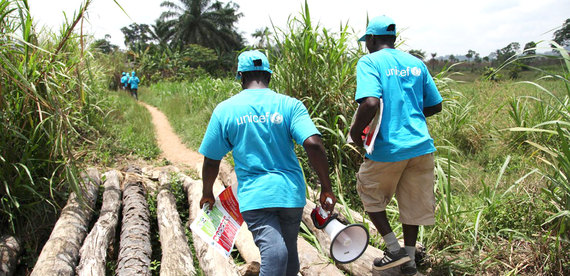WRITTEN BY:
Blair Palmer, UNICEF Innovation Lab Lead: San Francisco
Sibi Lawson-Marriot, UNICEF Humanitarian Policy Specialist
What if your design for good is really doing harm?
As part of a blog series surrounding the Wearables For Good Design Challenge, Blair Palmer, UNICEF Innovation Lab Lead: San Francisco interviewed UNICEF Humanitarian Policy Specialist, Sibi Lawson-Marriott to discuss the ethics of innovation and how UNICEF and partners work to ensure that good ideas truly yield good results.
Blair Palmer: Designers and technologists working in entrepreneurial or corporate settings have different considerations and goals than those who work for organizations like UNICEF. How are UNICEF's innovation goals and ethical policies different?
Sibi Lawson-Marriott: UNICEF is a child-centered organization, so naturally we are always on the lookout for innovations that will benefit children and their families. We also keep an eye on emerging innovations and technologies to make sure they won't have adverse effects on children and their families. Always putting children's interests first is our unique responsibility. This means we might define a 'problem' or a 'user' differently than someone working in the private sector space. Lastly, at UNICEF, we are very conscious about how different workspaces or processes can democratize or restrict innovation - our goal is to empower and enable people from all walks of life so that they are able to contribute.
BP: Why is the UNICEF perspective an important consideration for those who enter the Wearables for Good challenge?
SLM: One criteria we will use to judge Wearables For Good challenge entries is the idea's potential for positive social impact, vs. its profitability. We will look for ideas that are scalable so they can deliver good to a large group of people.
Personally, I am by expertise and experience a humanitarian specialist, so I'm always on the lookout for new ideas that can work in the very specific circumstances of a sudden crisis or in the complexity of a protracted, violent conflict.
BP: Are "ethics of innovation" for UNICEF any different than a more general "ethics of design"? If so, why? If not, explain.
SLM: I do believe there is a difference. There are elements of accountability to the affected population that may not be present in a purely deign-driven scenario. There are risks and power dynamics that make for a different kind of innovation process. There may be a need for more upfront investment in capacity building to enable a genuine, informed consent, and there may need to be reflection on how the benefits of the innovation can be most fairly shared amongst those who created it. This equity-based approach is an underlying principle for UNICEF in all areas of our work, not just in our work with technology and innovation.
BP: How does UNICEF develop its ethical viewpoints, especially when it comes to technology?
SLM: We start by applying the Principles for Innovation and Technology in Development, which has become a standard ethical framework that UNICEF developed some years ago. We work closely with private sector partners, academics, fellow practitioners (both development and humanitarian) and community and government representatives to share ideas about what ethical dilemmas or risks may exist. We also review comparable bodies of ethics, such as medical or research papers, and compare them with areas where we have had to develop ethical standards, such as interviewing children or conducting research that involves children. We know that in any interaction with crisis-affected populations there needs to be a method for collecting robust feedback and complaints and we incorporate technology to help us reach more people, faster. To continually evolve to changing situations, we operate in an open and collaborative setting with our colleagues in other UNICEF divisions as well as externally; our peer-to-peer discussions have been extremely fruitful as we often wrestle with similar challenges and it helps to share successes, failures, resources and recommendations.
BP: What are your ethical concerns around potentially designing wearable technology for resource constrained communities?
SLM: As with all new technologies, I am mindful of the sustainability of the good ideas that will come out of such a contest. I hope the judges will consider the secondary and tertiary effects of the new technologies and whether they will empower or disempower communities. Piloting, experimentation and rollouts of new technologies can have an impact on the social dynamics at community level and we are mindful of those as well.
BP: What opportunities for good do you see coming out of this design challenge?
SLM: I celebrate any mechanism that levels the innovation playing field, so to speak. There is no telling where the next new good idea will come from and game-changing, life-changing innovations so often feel like they are around the corner these days. Everyone should feel that if they have a good idea then they also have the ability to put it forward. I hope submissions will come from teams and partners; bringing people together around a challenge like this can sometimes have amazing results. Finally, I look forward to the potential for doing old things in new and better ways, in smarter and more efficient ways.
